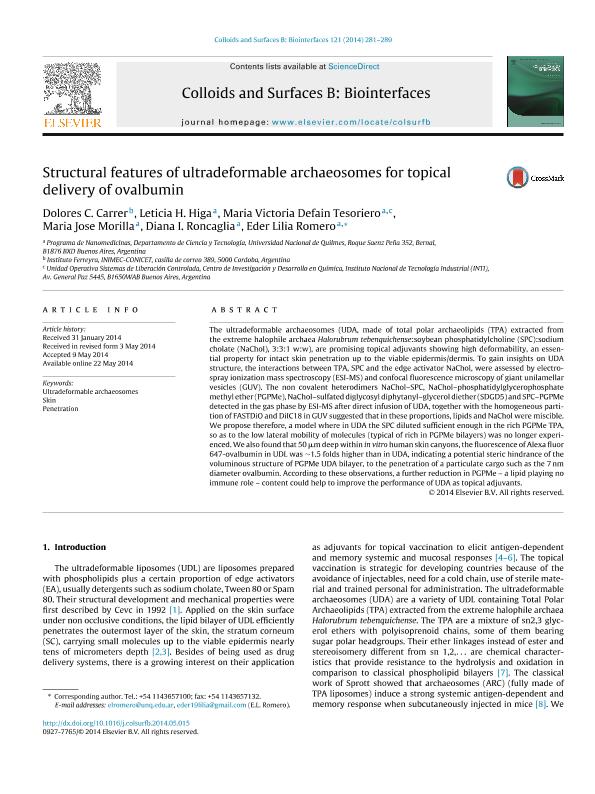Artículo
Structural features of ultradeformable archaeosomes for topical delivery of ovalbumin
Carrer, Dolores Catalina ; Higa, Leticia Herminia
; Higa, Leticia Herminia ; Defain Tesoriero, Maria Victoria; Morilla, María José
; Defain Tesoriero, Maria Victoria; Morilla, María José ; Roncaglia, Diana Inés; Romero, Eder Lilia
; Roncaglia, Diana Inés; Romero, Eder Lilia
 ; Higa, Leticia Herminia
; Higa, Leticia Herminia ; Defain Tesoriero, Maria Victoria; Morilla, María José
; Defain Tesoriero, Maria Victoria; Morilla, María José ; Roncaglia, Diana Inés; Romero, Eder Lilia
; Roncaglia, Diana Inés; Romero, Eder Lilia
Fecha de publicación:
05/2014
Editorial:
Elsevier Science
Revista:
Colloids and Surfaces B: Biointerfaces
ISSN:
0927-7765
Idioma:
Inglés
Tipo de recurso:
Artículo publicado
Clasificación temática:
Resumen
The ultradeformable archaeosomes (UDA, made of total polar archaeolipids (TPA) extracted from the extreme halophile archaea Halorubrum tebenquichense:soybean phosphatidylcholine (SPC):sodium cholate (NaChol), 3:3:1 w:w), are promising topical adjuvants showing high deformability, an essential property for intact skin penetration up to the viable epidermis/dermis. To gain insights on UDA structure, the interactions between TPA, SPC and the edge activator NaChol, were assessed by electrospray ionization mass spectroscopy (ESI-MS) and confocal fluorescence microscopy of giant unilamellar vesicles (GUV). The non covalent heterodimers NaChol–SPC, NaChol–phosphatidylglycerophosphate methyl ether (PGPMe), NaChol–sulfated diglycosyl diphytanyl–glycerol diether (SDGD5) and SPC–PGPMe detected in the gas phase by ESI-MS after direct infusion of UDA, together with the homogeneous partition of FASTDiO and DiIC18 in GUV suggested that in these proportions, lipids and NaChol were miscible. We propose therefore, a model where in UDA the SPC diluted sufficient enough in the rich PGPMe TPA, so as to the low lateral mobility of molecules (typical of rich in PGPMe bilayers) was no longer experienced. We also found that 50 μm deep within in vitro human skin canyons, the fluorescence of Alexa fluor 647-ovalbumin in UDL was ∼1.5 folds higher than in UDA, indicating a potential steric hindrance of the voluminous structure of PGPMe UDA bilayer, to the penetration of a particulate cargo such as the 7 nm diameter ovalbumin. According to these observations, a further reduction in PGPMe – a lipid playing no immune role – content could help to improve the performance of UDA as topical adjuvants.
Palabras clave:
Penetration
,
Skin
,
Ultradeformable Archaeosomes
Archivos asociados
Licencia
Identificadores
Colecciones
Articulos(INIMEC - CONICET)
Articulos de INSTITUTO DE INV. MEDICAS MERCEDES Y MARTIN FERREYRA
Articulos de INSTITUTO DE INV. MEDICAS MERCEDES Y MARTIN FERREYRA
Articulos(SEDE CENTRAL)
Articulos de SEDE CENTRAL
Articulos de SEDE CENTRAL
Citación
Romero, Eder Lilia; Roncaglia, Diana Inés; Morilla, María José; Defain Tesoriero, Maria Victoria; Higa, Leticia Herminia; Carrer, Dolores Catalina; et al.; Structural features of ultradeformable archaeosomes for topical delivery of ovalbumin; Elsevier Science; Colloids and Surfaces B: Biointerfaces; 121; 5-2014; 281-289
Compartir
Altmétricas



